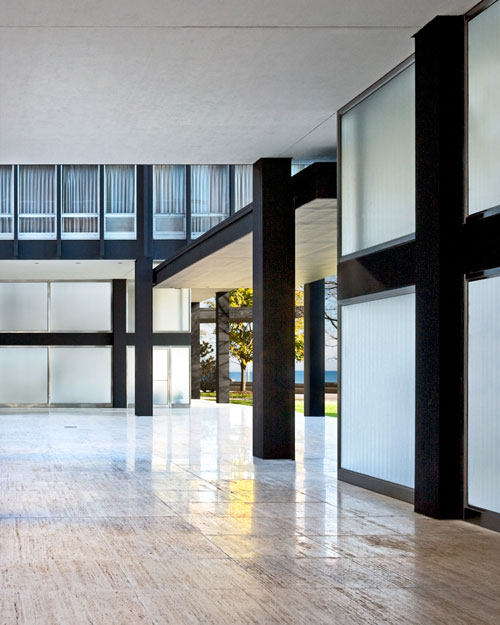Reviving
Recapturing that glow
Changing out the laminated glass for glazing more sympathetic to Mies's design intent had one unanticipated consequence: The designers and residents noticed that light emanating from ceiling fixtures just inside the storefront seemed no longer to softly backlight the sandblasted panels as it once had. Instead, the light source - fluorescent lamps inside asymmetrical linear reflectors - was now annoyingly discernible from the plaza.
The reflectors had been created specifically for 860-880 by architectural lighting design pioneer Richard Kelly as part of a complete exterior and lobby illumination scheme. Kelly had designed the fixtures around T12 lamps, which in the course of normal maintenance were swapped for the smaller diameter T6s. Although the different-size lamps produced the same amount of light, the narrower ones were more intense at the source, with an uneven distribution, explains Jim Baney, a partner at Schuler Shook, the restoration project's lighting consultant. The less historically accurate laminated glass had camouflaged this effect, but the more transparent sandblasted glass could not. The solution was to simply replace the lamps with T12s.
 |
Back-of-house areas are once again concealed by panels of sandblasted glass, as they were when the buildings were completed in 1951. Photo © William Zbaren |
Â
The project team also examined the plaza lighting as part of the restoration project. Kelly illuminated the area with downlights at the edge of the buildings' exterior soffits. His concept was "to make the travertine glow," says Baney.
But over the years, the fixtures, which had no lenses and thus were completely open to the elements, had rusted beyond repair. In addition, the original 300-watt R40 lamps had a very limited life span, necessitating their frequent replacement. Building staff had long ago substituted lower-maintenance, self-ballasted fluorescents. The end result was that the downlights were producing less than 25 percent of their original design output.
Baney and his team found a replacement fixture sympathetic to the architecture that could be installed from below into the existing soffit and offered protection from water penetration. The new downlights each house a 39-watt 3000K ceramic metal halide lamp with an operating life almost 12 times as long as the original incandescent lamps. The new lighting has a warmth and lumen output that approximates Kelly's design but consumes only a fraction of the energy, according to Baney. The goal, he says, "was to interpret the design using today's available technology."
Naturally, historic buildings, especially those as significant - and deceptively simple - as Mies's Lake Shore Drive towers, can benefit from the deployment of the latest technology. But sensitive restoration is much more complex. Reinvigorating older structures requires delicately balancing the desire for historical accuracy with a host of sometimes conflicting demands, including programmatic needs, code requirements, and tight budgets. In fact, suggests Sexton, restoration work is not all that different from designing a building from scratch. "It involves many of the same constraints."








